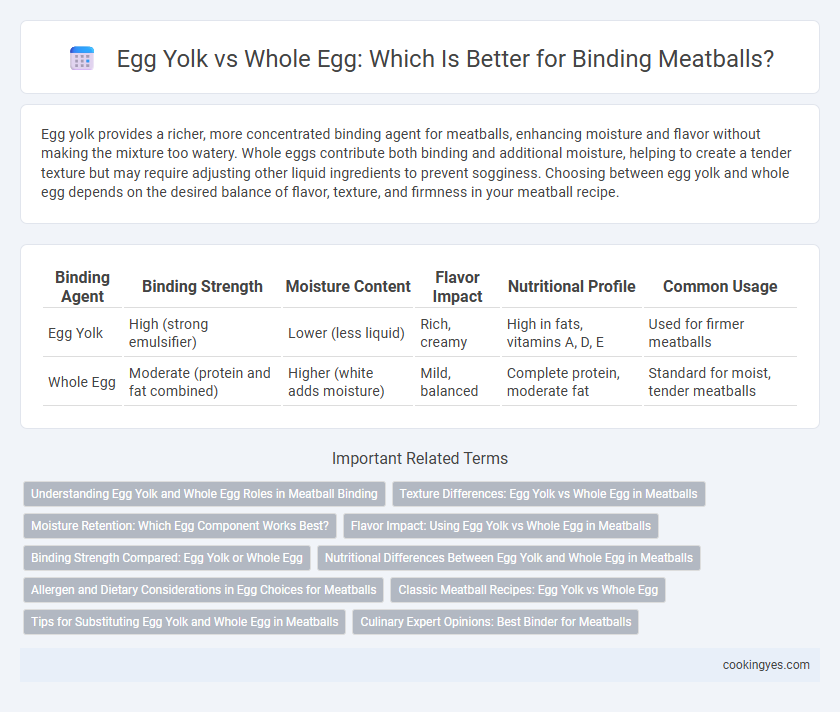Egg yolk provides a richer, more concentrated binding agent for meatballs, enhancing moisture and flavor without making the mixture too watery. Whole eggs contribute both binding and additional moisture, helping to create a tender texture but may require adjusting other liquid ingredients to prevent sogginess. Choosing between egg yolk and whole egg depends on the desired balance of flavor, texture, and firmness in your meatball recipe.
Table of Comparison
| Binding Agent | Binding Strength | Moisture Content | Flavor Impact | Nutritional Profile | Common Usage |
|---|---|---|---|---|---|
| Egg Yolk | High (strong emulsifier) | Lower (less liquid) | Rich, creamy | High in fats, vitamins A, D, E | Used for firmer meatballs |
| Whole Egg | Moderate (protein and fat combined) | Higher (white adds moisture) | Mild, balanced | Complete protein, moderate fat | Standard for moist, tender meatballs |
Understanding Egg Yolk and Whole Egg Roles in Meatball Binding
Egg yolk contains high levels of fat and lecithin, which enhance moisture retention and create a rich, tender texture in meatballs by binding ingredients effectively. Whole eggs combine the emulsifying properties of yolks with the structural proteins of egg whites, providing a firmer, more cohesive meatball that holds together well during cooking. Selecting egg yolk results in a softer bite, while whole eggs produce a sturdier, more resilient meatball binding.
Texture Differences: Egg Yolk vs Whole Egg in Meatballs
Egg yolk creates a richer, creamier texture in meatballs due to its higher fat content, enhancing moisture and tenderness. Whole eggs provide a firmer, more cohesive structure because of the combination of egg whites and yolks, which contributes to a slightly denser meatball. Choosing egg yolk results in softer meatballs, while whole eggs yield a balanced texture with improved binding strength.
Moisture Retention: Which Egg Component Works Best?
Egg yolks provide superior moisture retention in meatballs due to their higher fat content and emulsifying properties, which help bind juices and prevent dryness during cooking. Whole eggs contribute both moisture and structure, but the additional egg whites can draw out moisture, potentially leading to firmer, less juicy meatballs. For optimal moisture retention and a tender texture, using egg yolks as the primary binder is often more effective than whole eggs.
Flavor Impact: Using Egg Yolk vs Whole Egg in Meatballs
Egg yolk enhances meatball flavor by adding richness and a creamy texture due to its high fat content, giving a deeper, more savory taste. Whole eggs contribute a milder flavor while improving binding and moisture, balancing tenderness without overpowering the meat's natural taste. Choosing egg yolk over whole egg intensifies flavor complexity, ideal for recipes aiming for a luxurious, full-bodied meatball experience.
Binding Strength Compared: Egg Yolk or Whole Egg
Egg yolk provides stronger binding in meatballs due to its higher fat and emulsifying protein content, which enhances moisture retention and texture cohesion. Whole eggs offer a balanced binding effect, combining the yolk's emulsifiers with the albumen's coagulating proteins to create firm yet tender meatballs. For recipes prioritizing maximum structural integrity and a rich mouthfeel, egg yolk is often preferred over whole eggs.
Nutritional Differences Between Egg Yolk and Whole Egg in Meatballs
Egg yolk contains higher fat and cholesterol content compared to whole eggs, providing richer flavor and creamier texture in meatballs while contributing essential vitamins such as A, D, and E. Whole eggs offer a balanced combination of protein, fat, and moisture, enhancing the structural binding and tenderness of meatballs without excessive greasiness. Choosing between egg yolk and whole egg affects the nutritional profile, with whole eggs supplying more complete protein and less concentrated fat than yolks alone.
Allergen and Dietary Considerations in Egg Choices for Meatballs
Egg yolk offers a richer texture and stronger binding in meatballs but contains higher levels of allergens such as egg proteins that can trigger reactions in sensitive individuals. Whole eggs provide a balanced mix of egg white and yolk proteins, offering moderate binding while potentially causing fewer allergic responses due to dilution of allergenic proteins. Choosing between egg yolk and whole egg for meatball binding requires considering dietary restrictions, including egg allergies, cholesterol concerns, and preferences for lower allergen exposure.
Classic Meatball Recipes: Egg Yolk vs Whole Egg
Classic meatball recipes often debate the use of egg yolk versus whole egg for optimal binding, with egg yolks providing richer moisture and a tender texture due to their higher fat content. Whole eggs contribute both white and yolk, offering stronger structural integrity and a firmer bite by combining proteins that coagulate during cooking. Selecting between egg yolk and whole egg impacts meatball consistency, moisture retention, and flavor, influencing the final dish's juiciness and mouthfeel.
Tips for Substituting Egg Yolk and Whole Egg in Meatballs
Egg yolk provides rich fat content and stronger binding, resulting in moist, tender meatballs, while whole eggs offer added moisture and structure with a balance of white and yolk proteins. When substituting, use one whole egg for every two egg yolks to maintain moisture and binding properties without over-softening the mixture. Incorporate additional breadcrumbs or a splash of milk to adjust texture and prevent meatballs from becoming too dense or dry when altering egg ratios.
Culinary Expert Opinions: Best Binder for Meatballs
Culinary experts often favor whole eggs over egg yolks alone for meatball binding due to their balanced combination of moisture and protein, which enhances texture and cohesion. Whole eggs contribute to a juicier interior while maintaining structural integrity during cooking, ensuring meatballs hold together without becoming dry. Egg yolks, though rich and flavorful, can create a denser binder that may lead to a firmer meatball, lacking the optimal balance sought by professional chefs.
Egg yolk vs Whole egg for meatball binding Infographic

 cookingyes.com
cookingyes.com